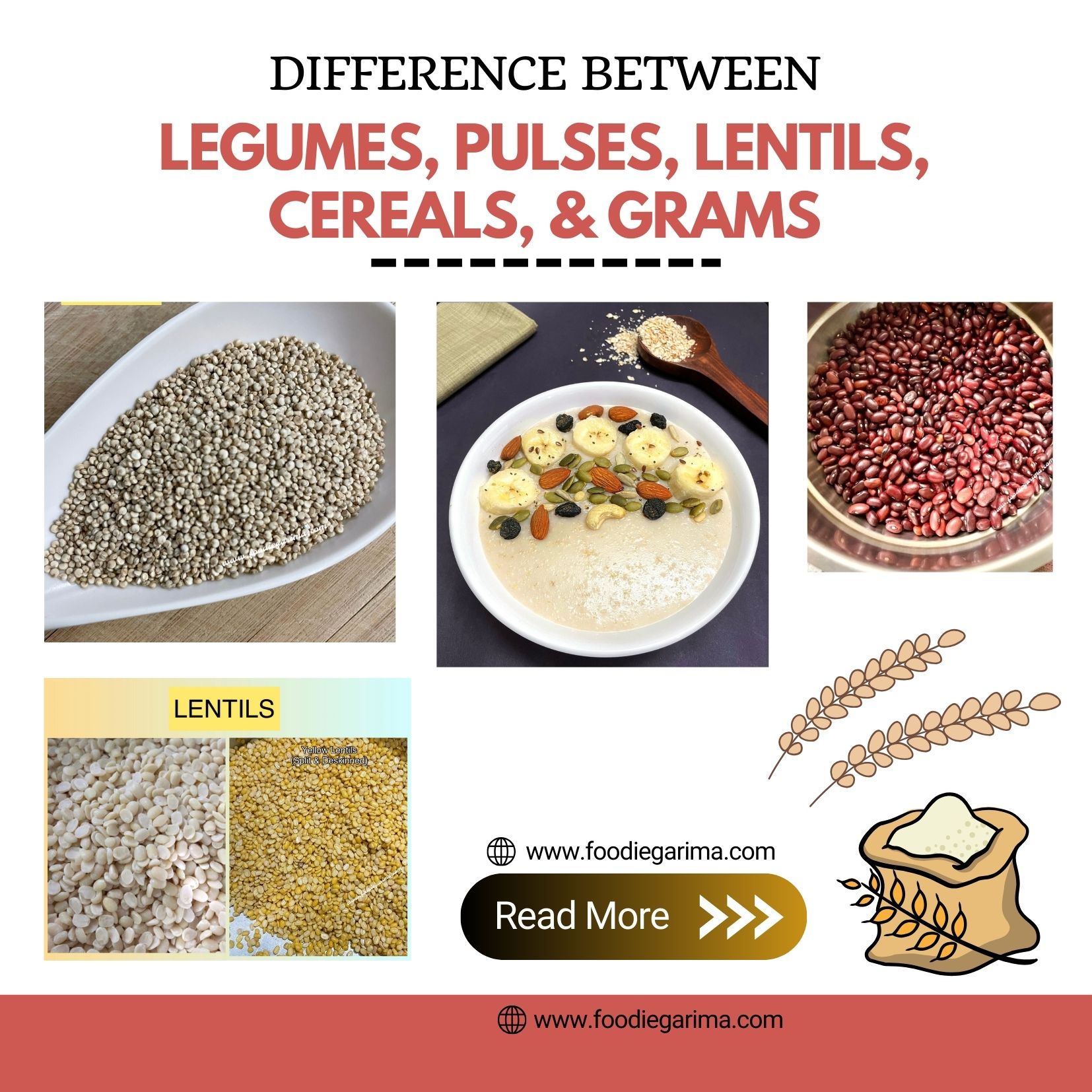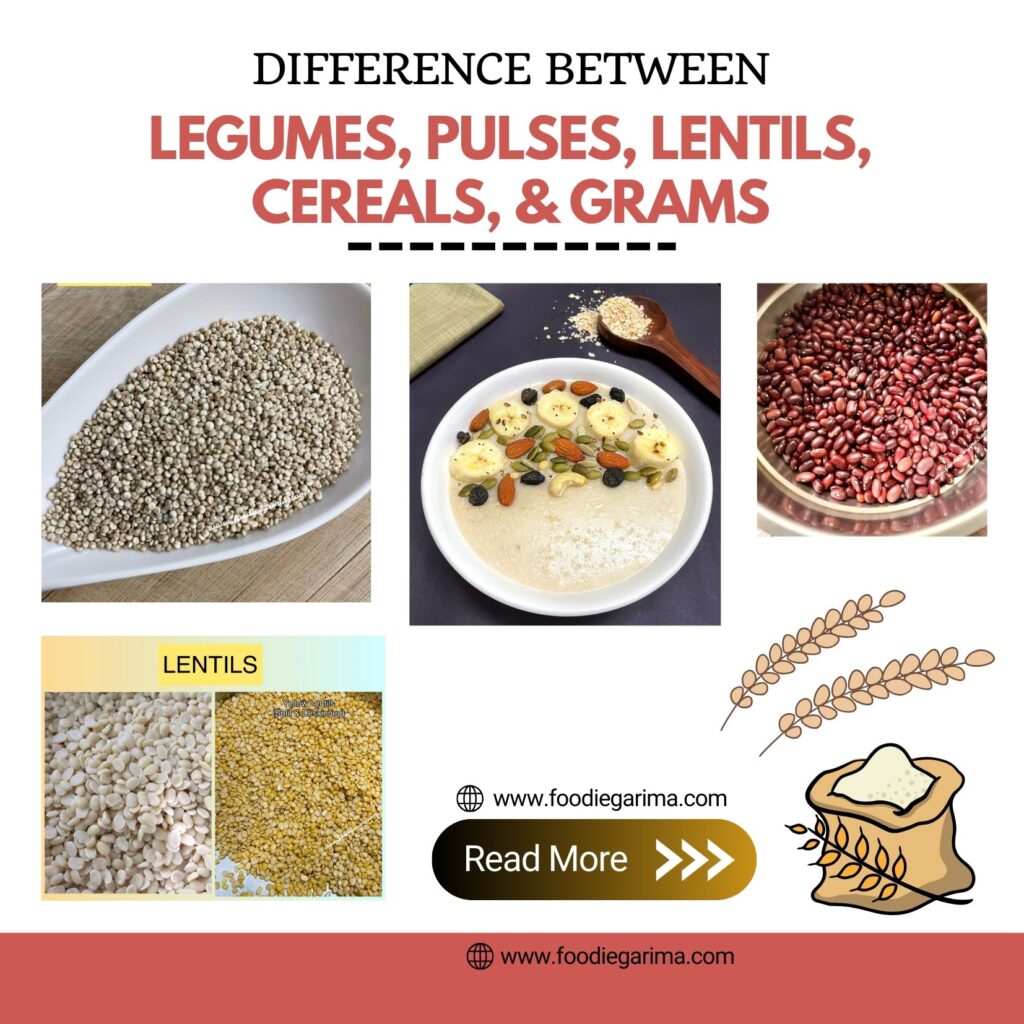7 January, 2025
Difference Between Pulses, Cereals, Legumes, Lentils, and Grams

Difference Between Pulses, Cereals, Legumes, Lentils, and Grams
When navigating the world of plant-based foods, terms like pulses, cereals, legumes, lentils, and grams often pop up. While they might seem interchangeable, each has distinct meanings and roles in our diets. Let’s unravel the differences and understand how these nutrient-rich foods contribute to our meals.
What Are Legumes?
Definition: Legumes refer to plants in the Fabaceae family. They include plants that produce seeds or pods, which are consumed as food.
Examples:
- Soybeans
- Peanuts
- Green peas
- Lentils
Key Features:
- Includes both fresh and dried forms
- Nitrogen-fixing plants that enrich soil fertility
- Rich in protein and essential nutrients
Usage: Legumes can be eaten fresh (like green beans) or dried (like lentils and chickpeas).
What Are Pulses?
Definition: Pulses are the edible seeds of plants in the legume family. They are dried seeds that are low in fat and high in protein and fiber.
Examples:
- Chickpeas (garbanzo beans)
- Black beans
- Kidney beans
- Dry peas
Key Features:
- High in protein and fiber
- Gluten-free
- Excellent for vegetarians and vegans
Usage: Pulses are versatile and can be used in soups, salads, curries, and stews.
What Are Lentils?
Definition: Lentils are a specific type of pulse, small, lens-shaped seeds that come in various colors and flavors.
Examples:
- Red lentils
- Green lentils
- Brown lentils
- Yellow lentils
Key Features:
- Quick to cook compared to other pulses
- High in protein, iron, and folate
- Affordable and widely available
Usage: Lentils are popular in soups, stews, and salads. They are also a key ingredient in Indian dal.
What Are Cereals?
Definition: Cereals are grasses cultivated for their edible grains. They are rich in carbohydrates and serve as staple foods around the world.
Examples:
- Wheat
- Rice
- Corn
- Barley
- Oats
Key Features:
- Primary source of energy
- Often processed into flour or meals
- Provide dietary fiber, vitamins, and minerals
Usage: Commonly used in bread, pasta, breakfast cereals, and porridge.
What Are Grams?
Definition: Grams are a type of pulse, commonly referred to as chickpeas or Bengal gram in many cuisines.
Examples:
- Green gram (mung beans)
- Black gram (urad beans)
- Bengal gram (chickpeas)
Key Features:
- High in protein and fiber
- Gluten-free
- Used in flour form (e.g., gram flour or besan)
Usage: Grams are used in curries, soups, and snacks like falafel and pakoras.
How Are They Different?
| Category | Definition | Examples | Primary Nutrients |
|---|---|---|---|
| Legumes | Plants producing Seeds or Pods | Pulses, Soybeans, Peanuts, Fresh Green Peas | Protein, essential nutrients |
| Pulses | Dried Seeds of Legumes | Lentils, Chickpeas, Kidney Beans, Black Beans | Protein, fiber |
| Lentils | Small, lens-shaped Pulses | Red Lentils, Green Lentils | Protein, iron, folate |
| Cereals | Grains from grasses | Wheat, Rice, Oats | Carbohydrates, vitamins, minerals |
| Grams | Specific types of Pulses, often Chickpeas or related Beans | Black Gram, Green Gram | Protein, fiber |
Why Are These Foods Important?
- Nutritional Powerhouses: Each category provides essential nutrients like protein, carbohydrates, vitamins, and minerals.
- Versatility: They can be used in various cuisines and cooking methods.
- Affordability: Lentils, grams, and cereals are cost-effective options for balanced meals.
Note:
- All Pulses Are Legumes, But Not All Legumes Are Pulses: While pulses are a subset of legumes. Legumes also include fresh varieties like green beans and peanuts.
- Cereals Are Not Proteins: Cereals are primarily carbohydrate-rich, unlike pulses and lentils, which are protein-rich.
- Lentils and Grams Are the Same: Lentils are a broader category, while grams are specific types of pulses.
Understanding the differences between pulses, cereals, legumes, lentils, and grams helps us appreciate their unique contributions to our diets.
FAQs
1. Are lentils and pulses the same?
Lentils are a specific type of pulse, but not all pulses are lentils.
2. Can cereals provide protein?
Cereals primarily provide carbohydrates, but some, like quinoa, also contain protein.
3. What is the difference between grams and lentils?
Grams are specific types of pulses, such as chickpeas and black gram, while lentils are small, lens-shaped seeds.
4. Are legumes always dried?
No, legumes can be fresh (like green beans) or dried (like chickpeas and lentils).
5. Why are pulses good for vegetarians?
Pulses are high in protein, fiber, and essential nutrients, making them a great meat substitute for vegetarians.
